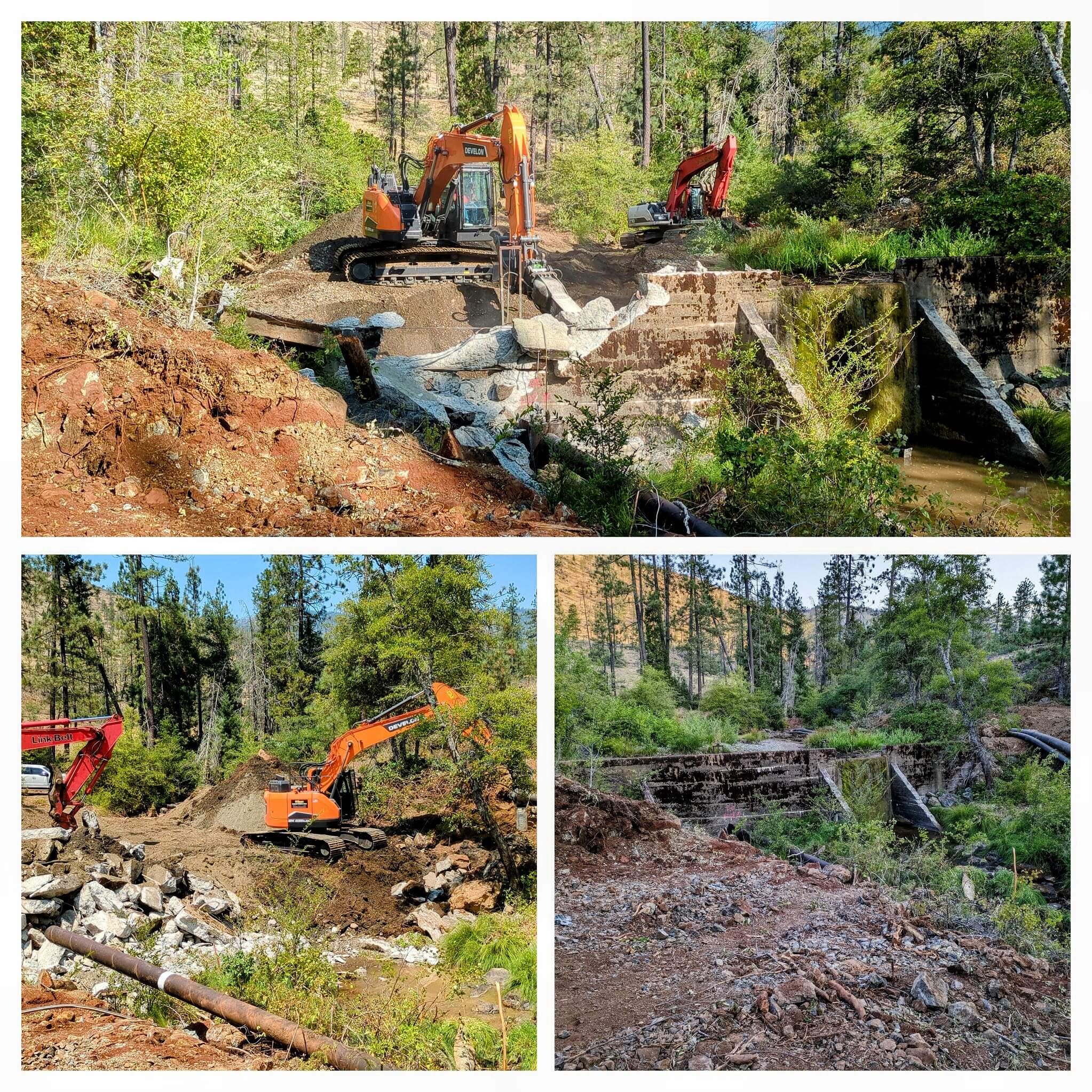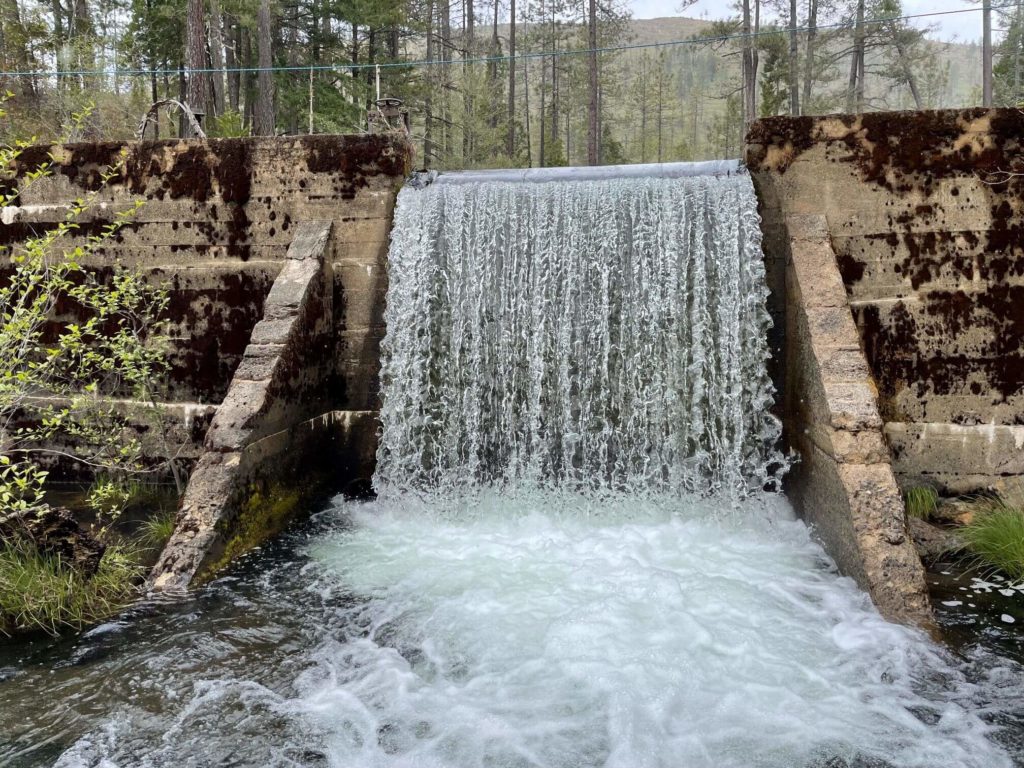By Shaun Hall | Oct. 6, 2023 | Rogue Valley Times
Fish have a bit more room to roam now that a 13-foot-high dam has been removed from a tributary of the Illinois River near Selma in Josephine County.
The dam was removed in recent days from a property that decades ago operated as a cattle ranch frequented by actor John Wayne and which is now owned by the Siskiyou Field Institute, a non-profit educational and research organization.
Illinois River Road stretches past the location, leading to the popular “scenic segment” of the Illinois River, one of the nation’s designated Wild and Scenic Rivers.
The dam and two fish-blocking culverts were removed from Takelma Creek, formerly known as Squaw Creek, about one mile west of U.S. Highway 199. Takelma Creek flows into Deer Creek, which flows into the Illinois River. Both the road and the creek extend past the location and into adjacent federal property managed by the Bureau of Land Management and the U.S. Forest Service.
They are among the latest structures to be removed in order to improve fish passage and water quality in the Rogue River watershed, with more dam and culvert removals expected in coming years. The latest removals opened up 3.5 miles of stream habitat, including habitat that extended into adjacent federal land. Taxpayers funded the work, at an estimated cost of $1.1 million.
Related road work continued this week near the dam site, which is on property acquired nearly 20 years ago by the Siskiyou Field Institute, about a year after the organization’s founding.
“We feel as an organization that this was an important project,” said Steve Soesbe, executive director of the Siskiyou Field Institute.
The organization sought removal of the dam, which is on a state list of fish-blocking structures. News of the removal was announced Wednesday by WaterWatch of Oregon, which secured an agreement with the institute to demolish the dam at no cost to the organization.
“It was built by a rancher in the 1950s as best we can tell, maybe in the 40s,” said Jim McCarthy, Southern Oregon program director for WaterWatch. “They just built the dam without a fish ladder.”
Only the strongest of fish could get over the structure, he said.
In place of the dam, workers installed a fish-friendly, screened structure in the creek to divert water that then flows by gravity in a new pipe for use as irrigation or tap water.
According to Soesbe, the institute’s 840 acres takes in a former ranch frequented by actor John Wayne, whose buddy owned the place. Wayne, whose real name was Marion Robert Morrison, stabled horses there and helped out.
Wayne, who starred in many Western films, died in 1979. There’s now a John Wayne room at the institute’s facility, which has four guest rooms for rent, an area for camping and space for RVs, in addition to facilities for classes, events and conferences.
Soesbe said the property is subject to a conservation easement that requires the institute to file a management plan with the state every five years. The plan is to restore the floodplain there and improve water quality, according to Soesbe.
“This is kind of a Phase One of our aquatic restoration,” he said.
Next up is replacement of a fish-blocking culvert through which Deer Creek flows. The culvert, known as an open-bottom culvert, would essentially span the waterway, but leave a flat, rocky channel in place.
Funding for the Takelma Creek work included $980,000 from the U.S. Forest Service and $15,666 secured by the Rogue Basin Partnership from the charitable Resources Legacy Fund. Other funders included Pacificorp and the Oregon Department of Fish and Wildlife.
River Design Group of Corvallis engineered and managed the project, while Dietrich Construction of Grants Pass demolished the dam, installed the screened water diversion and replaced culverts.
McCarthy said state and federal agencies deem the upper reaches of Deer Creek to be important in the recovery of Southern Oregon and Northern California coho salmon, which are listed as threatened under the Endangered Species Act. In addition to coho salmon, Takelma Creek provides spawning and rearing habitat for winter steelhead and cutthroat trout, he said.
Dam removal project manager Scott Wright, principal engineer for River Design Group, grew up fishing the Illinois River.
“It is deeply satisfying to be a part of this collaborative effort to restore salmon and steelhead to this beautiful stretch of creek,” Wright said, in a written statement. “Removing these barriers creates an unhindered pathway for salmon and steelhead between the ocean and prime freshwater spawning and nursery habitat, and increases this watershed’s overall resiliency against the harms of climate change.”
The dam is on a state list of structures deemed important to remove, although it was deemed a relatively low priority because the habitat opened up by its removal — 3.5 miles — is less than other higher-priority waterways. In contrast, Lovelace Dam, removed from Slate Creek this summer, opened up 26 miles of habitat. Lovelace Dam was a high-priority Group 2 dam, while Takelma Dam was a Group 15 dam.
“The more miles upstream, the higher the priority,” McCarthy said. “The more of a barrier to fish, the higher the priority.”
Hundreds of dams and culverts are on the state list, which currently is undergoing revisions by the Oregon Department of Wildlife (ODFW). Public comment on the list can be made at an ODFW Fish Passage Task Force meeting set for Oct. 13 in Salem, or at later times.
McCarthy expects other dams to come down, spurred on in part by the availability of funding under the Infrastructure Investment and Jobs Act of 2021. Several other dams and structures have come down in the last two decades, including dams on the Rogue River and about 20 others in the watershed in the last six years. On the Klamath River, one dam was removed this year, with two more slated for removal next year.
“I think you can rest assured, given the amount of funding for barrier removals provided through the stimulus, and the expertise that’s been developed in the Rogue Basin, that there will be more removals in the near future, but I can’t discuss those now,” McCarthy said. “People can expect the pace of removal to continue for three to five years at least.”
McCarthy said removal of the structures provides jobs to construction workers, engineers, biologists and others. He also said that healthy fish runs provide food for consumers, recreation for fishermen and income for fishing-related businesses. In addition, water quality is improved.
Still, there’s a cost to taxpayers to remove dams on private property.
“It’s a compromise to meet the need to address these barriers as soon as possible in the face of mounting climate change impacts,” McCarthy said. “These incredibly valuable runs, it’s clear there’s a substantial public benefit.”
This article originally appeared in the Oct. 6, 2023, edition of the Rogue Valley Times. Photos courtesy of River Design Group.


